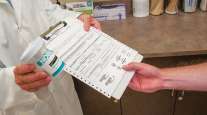Senior Reporter
Drug Testing Failure Rate for ‘Safety-Sensitive’ Workers Soars

The percentage of U.S. workers in “safety-sensitive” jobs — a category that includes truck drivers — who flunked their federally-mandated drug tests increased at an “alarming” rate from 2015 to 2016, according to an analysis of drug testing data collected by the nation’s largest lab. Overall, the percentage of safety-sensitive workers who failed crept up year-over-year, the report said.
The positive test rates for all U.S. workers drug tested by Quest Diagnostics in 2016 were the highest in 12 years.
The analysis of the data compiled earlier this year by Quest showed that the positive drug test results of safety-sensitive workers detecting cocaine increased by more than 7% from 2015 to 2016, while marijuana-positive test results jumped nearly 10% over the same period and increased more than 23% from 2012 to 2016.
Likewise, positive test results for safety-sensitive workers detecting methamphetamines jumped 14% from 2015 to 2016, and by 64% from 2013 to 2016. Positive test results for opiates increased by 16.7% from 2012 to 2016, but remained at the same level in both 2015 and 2016, Quest said. Workers with safety-sensitive jobs who were tested were mostly truck drivers, but the 2.2 million test samples also included certain employees in aviation, railroads, mass transit, pipelines and other transportation industries.
I understand why marijuana might be higher because of the legalization that’s going on across the country and people not realizing that they can’t use marijuana when they’re a driver with a commercial driver license.
Abigail Potter, manager of safety and occupational health policy for American Trucking Associations
Despite the 2016 increase, the drug positivity rate for all U.S. workers, including those with safety-sensitive jobs, has declined over the long term, falling from 13.6% in 1988 to 4.25% in 2016--the highest it has been since a 4.5% rate in 2004.
The overall rate for Quest’s testing for safety-sensitive jobs in 2016 was 2%, up from 1.8% in 2015.
Quest said that the positivity rate was 10.5% for the more than 1.3 million worker tests it processed in 2016 using hair samples. Although some fleets have been hair testing their employees for some time, only urine testing is allowed for DOT-mandated driver drug tests.
However, the 2015 FAST Act highway law required the Department of Health and Human Services to issue guidance for hair testing by Dec. 4, 2016. That date has passed, and a rule on hair testing is not expected for months, according to the Substance Abuse and Mental Health Services Administration.
Positive post-accident drug test results increased 25% from 2012 to 2016.
“The individuals who hold jobs in ‘safety-sensitive’ capacities carry a tremendous responsibility each time they perform their duties,” Barry Sample, Quest’s senior director for science and technology, said in an Oct. 19 statement. “The increase among safety-sensitive workers is an additional, disturbing sign of the rising drug misuse and illegal drug use in the U.S. workplace.”
Sample added, “The findings related to post-accident testing results should also be of particular concern to employers because drug or alcohol may have caused or contributed to workplace safety incidents.”
The Quest safety-sensitive worker 2016 positive result rate is slightly higher than those reported by the Department of Transportation in June.
The overall DOT 2016 drug testing failure rate for all tests reported by certified labs increased to 1.98% from 1.85% in 2015, which includes random, pre-employment, post-accident, “reasonable suspicion” and return-to-duty drug tests.
The DOT drug testing report of 5.5 million lab-reported random DOT tests was the highest overall failure level since at least 2009, including year-over-year increases in three of five drug categories.
Why are the numbers going up?
“That’s a very good question,” said Abigail Potter, manager of safety and occupational health policy for American Trucking Associations. “I understand why marijuana might be higher because of the legalization that’s going on across the country and people not realizing that they can’t use marijuana when they’re a driver with a commercial driver license.”
The increases also could be the result of improvements in the economy and more people employed in the trucking industry, Potter added.




